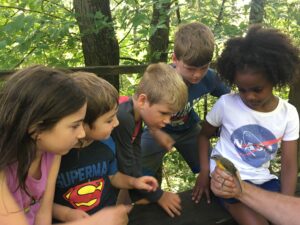By Andrew Berry
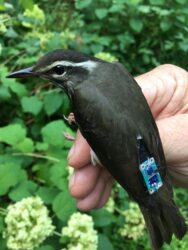
Thanks to your generous support on Kentucky Gives Day 2019, we are thrilled to announce our newest bird conservation initiative. Between July 19-22, we installed three Cellular Tracking Technologies (CTT) SensorStations, 25 CTT Nodes, and deployed 11 of 25 CTT LifeTagsTM on four species of birds, making Bernheim the first in Kentucky to join the global MOTUS Wildlife Tracking System. Partnering with Cellular Tracking Technologies and the Office of Kentucky Nature Preserves, this new infrastructure provides cutting edge capabilities for wildlife tracking, environmental education, and bird research, and further establishes Bernheim as a regional leader in wildlife conservation technology.
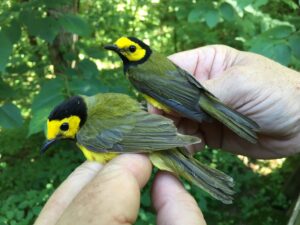
This project is an extension of Bernheim’s 90 years of research within our large interior forest. Previous studies have explored habitat use and bird migrations that includes ongoing tracking of Golden Eagles at Bernheim. This first phase of tagging is targeting Purple Martin, Kentucky Warbler, Wood Thrush, Indigo Bunting, and Louisiana Waterthrush for tracking.
For the 2019 tracking project we are targeting up to 25 individuals of the following five species of Neotropical migrants: Purple Martin, Kentucky Warbler, Wood Thrush, Indigo Bunting, and Louisiana Waterthrush. These birds were selected because they represent some of Bernheim’s most charismatic breeders, are members of the “Partners in Flight” watchlist and species of greatest conservation need. They were chosen based on their likelihood of capture based on previous mist-netting on Bernheim and point counts (a point count is a tally of all birds detected by sight and sound by a single observer located at a fixed position during a specified period of time).
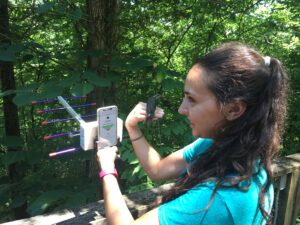
All banding and tagging are done only by licensed bird banders and under strict federal permits. In our case all banding was done by Zeb Weese of the Office of Kentucky Nature Preserves (KNP), whose agency conducts biological inventories on natural areas throughout the state. All transmitter attachment was carried out by Michael Lanzone of Cellular Tracking Technologies (CTT), who trained Zeb and others on the various harnessing techniques for safely attaching LifeTag transmitters to songbirds. In the first week of deployment we fitted 4 Louisiana Waterthrush, 6 Purple Martin, 1 Kentucky Warbler, and 1 Wood Thrush with cutting-edge CTT LifeTag transmitters.
Data collected over the next days, weeks, months and years will exponentially increase our understanding of how birds use Bernheim’s habitats, identify species migrating through Bernheim, facilitate networking with other bird researchers using MOTUS, and provide outreach and education to our visitors and the greater public.
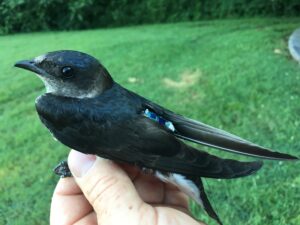
The MOTUS Wildlife Tracking System is an international network of researchers using coordinated base stations to study movements of wildlife on local, regional, and hemispheric scales. CTT LifeTags are tiny solar powered transmitters produced by Cellular Tracking Technologies that are attached to birds and communicate with CTT SensorStations and CTT Nodes, which are linked directly to the MOTUS network. LifeTags allow birds to be tracked through multiple migrations, year after year, without worry of battery life, with transmitters as light as 0.46 grams. The sub-gram weight and battery-free design of the new LifeTag allows for tagging smaller animals while not compromising the duration of the project. Each LifeTag contains a globally unique digital ID, allowing researchers to discern between a nearly unlimited number of animals and differentiate between different projects and studies.
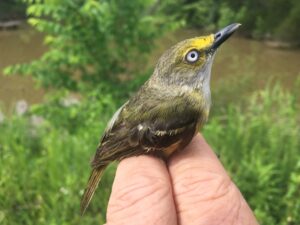
Since 2012, more than 16,581 individuals of over 171 species of birds and other wildlife have been tracked by over 232 projects in 28 countries. This network of 525 partners and collaborators tracks wildlife during all phases of the annual cycle (breeding, migration, and nonbreeding), and at a variety of spatial scales, resulting in novel insights into the movement behavior of small flying animals.
With our new installation, Bernheim fills an important gap in the existing MOTUS network in North America. Should an individual bird, tagged anywhere in the world with a transmitter, pass by a Bernheim SensorStation or Node, that information will be transmitted back to the network and the appropriate researcher provided the data. Equally interesting, if one of our Bernheim-tagged birds flies over a MOTUS station elsewhere on its migration route, that information will be transmitted back to us, ultimately adding to our greater understanding of bird and other wildlife migration.

Within the Bernheim Arboretum, we have installed a SensorStation and 25 CTT Nodes at 200m spacing to provide excellent spatial resolution for tracking and interpreting wildlife habitat usage. A second base station on the fire tower will provide data from a wider geographical range, with sweeping views of the Kentucky sky, creating a checkpoint for all migrating birds passing over the region in any direction. The third base station, at the Bean Research Lodge, will stretch our coverage into Nelson County and cover the interior forests of the Wilson Creek Valley. Soon we will be installing a data portal display at the Bernheim Education Center that gives visitors a real-time look at what our tagged birds are doing throughout Bernheim.. A handheld CTT Locator unit will also be available for researchers or school groups to provide real-time tracking of animals in the field, adding a high-tech educational tool that significantly contributes to our research and outreach goals.
Join us as we follow these migrating birds on their journey to locations in the Caribbean Islands, Central America, and South America, or right here at Bernheim. We hope to tell a story about their long distance migrations that will include winter and summer residence, habitat usage, and migration routes. Information will benefit the greater bird research community and further our goal to protect bird habitats both in Bernheim and beyond as well as our mission to connect people with nature. Efforts at protecting land throughout these bird’s extensive yearly ranges will be critical for keeping these species in existence for centuries to come. Thank you for your interest and support!


